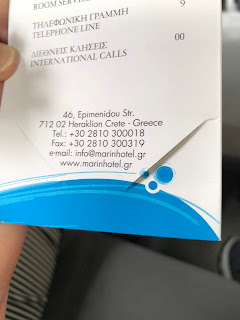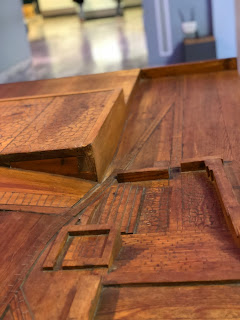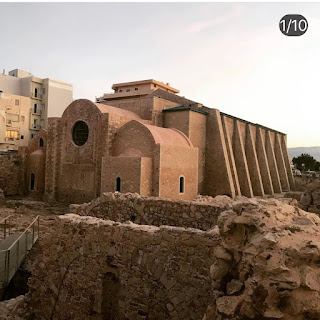Moderately good sleep. We ate like the greeks do last night. LATE! 10 pm is dinnertime in Greece.
Breakfast. Bye Chania. Love you!
Palace of Knossos. There was a really cool digital youtube reconstruction of the palace. But the user disappeared so I can't show it to you! There's so much to tell about Knossos and the Minoan civilization. Lets do the pictures first:
grecian urns
throne room
My favorite shot. Cool staircase!
Dolphins in the queens chambers
the minotaur
Don't get too close or the people will blow whistles at you!!!
(We didn't get whistled at.)
photo credit: Brent (There's Chris, Julia and I in the crowd, up on top!)
So, ok. Knossos. Here's the wikipedia if you want to read ALL THE THINGS.
https://en.wikipedia.org/wiki/Knossos
Short version: Knossos was the capital of Minoan Crete. It was grander and more flamboyant than any of the palaces known to us. It is about 20 minutes south of Heraklion. It was the center of administration of the entire island during Minoan times. But before that, the palace was inhabited beginning with a neolithic settlement sometime in the seventh millennium BC. The first palace on the low hill beside the Krairatos river was built around 1900 BC on the ruins of previous settlements. It was destroyed the FIRST TIME along with other palaces on Crete at 1700 BC, probably by a large earthquake. It was immediately rebuilt to an even more elaborate level until finally its abandonment due to more earthquakes, invasions, the colossal volcanic eruption of Thera in 1450 BC, and the invasion of Mycenaeans who used it as their capital as they ruled the island of Crete until 1375 BC. This marked the end of the Minoan civilization. I MEAN, we are talking seriously ancient history here. (*brain explosion*)
A British Archaeologist, named Sir Arthur Evans, excavated the site in 1900 AD. He restored parts of the palace in a way that it is possible today to appreciate the grandeur and complexity of a structure that evolved over several millennia. Walking through the complex multi-storied buildings, one can comprehend why the palace was associated with the mythological labyrinth.
According to Greek mythology, the palace was designed by famed architect Dedalos with such complexity that no one placed in it could ever find its exit. King Minos who commissioned the palace then kept the architect prisoner to ensure that he would not reveal the palace plan to anyone. (Rude!) The Labyrinth was also the dwelling of the Minotaur in Greek mythology, a half-man half-bull creature that devoured young virgins (well, that's horrific), and many associate the palace with the legend of Theseus killing the Minotaur.
(The above was paraphrased from here: https://ancient-greece.org/archaeology/knossos.html)
Some people get upset about Sir Arthur Evans restorations, saying they are not accurate. However, I appreciate the effort. I personally enjoyed conceptualizing what the palace looked like for real. I have a hard time truly appreciating the pile of rocks, especially when my brain physically can't comprehend HOW OLD THAT PILE OF ROCKS ACTUALLY IS. I want to know the stories that accompany the pile of rocks. (which is why the dioramas in the museums were my very favorite things!!!)
Oh hey! Not the same video, but almost as good. And it features the Phaestos Disc at the end!
Another one with intriguing music and fire pits!
So, anyways. There was the site of Knossos. Our admission includes the museum in the center of Heraklion, which we go to later today!! We checked into our hotel in Heraklion and dropped off laundry at a nearby laundry service. Then Chris and I headed off alone for couple-adventure-time. I took a picture of our hotel address in case we get lost. ha.
We were so hungry that we stopped at the first appealing lunch spot. It was probably our least favorite meal. Oh well. I got another greek coffee that I didn't enjoy. Greeks like so much sugar in their coffee. Probably to cover up how bitter it is!!!!!! However, I did discover the greek coffee with ice cream, later in the trip. That's delicious. I mean, Ice Cream.
Lunch in Heraklion
Heraklion harbor
After lunch, our first solo adventure was the Fortress of Koules in the Heraklion harbor. A whole different era of history to discover here: The Turkish occupation. And I've read that to be called a Turk is an insult, due to the still lingering feelings about this time in history. Takeway: This was the site of a siege that lasted 21 years!!!!!!!!Wikipedia:
The Koules (Greek: Κούλες) or Castello a Mare ("Fort on the Sea" in Italian) is a fortress located at the entrance of the old port of Heraklion, Crete, Greece. It was built by the Republic of Venice in the early 16th century, and is still in good condition today.
The site was possibly first fortified by the Arabs in the 9th or 10th centuries. By the second Byzantine period, a tower known as Castellum Comunis stood on the site.[1] In 1303, the tower was destroyed in an earthquake but was repaired.[2]
In 1462, the Venetian Senate approved a programme to improve the fortifications of Candia. Eventually, the Byzantine tower was demolished in 1523, and the Castello a Mare began to be built instead. Old ships were filled with stone, and were sunk to form a breakwater and increase the area of the platform on which the fortress was built. The fortress was completed in 1540.[1]
In 1630, the fort was armed with 18 cannons on the ground floor, and 25 cannons on the pathway leading to the roof.[2]
During the 21-year long Siege of Candia, Ottoman batteries easily neutralized the fort's firepower. The Ottomans eventually took the fort in 1669, after the Venetians surrendered the entire city. They did not make any major alterations to the fort, except for the additions of some battlements and embrasures. They built a small fort known as Little Koules on the landward side, but this was demolished in 1936 while the city was being "modernized".[1]
The fortress has been restored, and it is now open to the public.[2] Art exhibitions and cultural activities are occasionally held at the fort.[1]
The fortress is made up of two parts: a high rectangular section, and a slightly lower semi-elliptical section. Its walls are up to 8.7m thick at some places, and it has three entrances. The fort has two stories, with a total of 26 rooms, which were originally used as barracks, a prison, storage rooms, a water reservoir, a church, a mill and a bakery.[2]
A lighthouse tower is located on the northern part of the fort.[3]
butt
photo credit: Chris
photo credit: Chris
So after the fortress, we wandered around Heraklion with the eventual goal of reaching the museum.
I need a map.
photo credit: Chris
photo credit: Chris
We found the museum!!
butt
I'm certain those are tea cups. hehe.
This wooden diorama was my favorite thing!!!!!
These were huge!!! They took up the entire wall, floor to almost ceiling.
photo credit: Chris
First, this museum was incredible. I regret not having seen the Phaestos disc. My brain was so tired and saturated that its completely possible that I just OVERLOOKED it. UGH! If I ever go back, I'm taking 2 shots of espresso before I go in for optimal soakage!
More wanderings around Heraklion.
Photo credit: Chris
photo credit: Chris
photo credit: Chris
its all greek to me
Then we headed back to the hotel and picked up our laundry. yay! clean clothes! (However I discovered that greek laundry service has extremely fragrant laundry detergent, and I AM STILL washing out the smell of that detergent from my clothes I had on the trip. STILL.)
More Heraklion exploring before dinner. Walking around Europe is my favorite.
photo credit: Chris
photo credit: Chris
photo credit: Chris
photo credit: Chris
photo credit: Chris
mushrooms. A specialty on Crete.
mushrooms. A specialty on Crete.
photo credit: Chris
Dolmas. #allthegrapeleaves
photo credit: Brent
The crew with Kostas
The crew with Kostas
Another late night for dinner. I'm turning Greek. But a super fun day.





























































































No comments:
Post a Comment